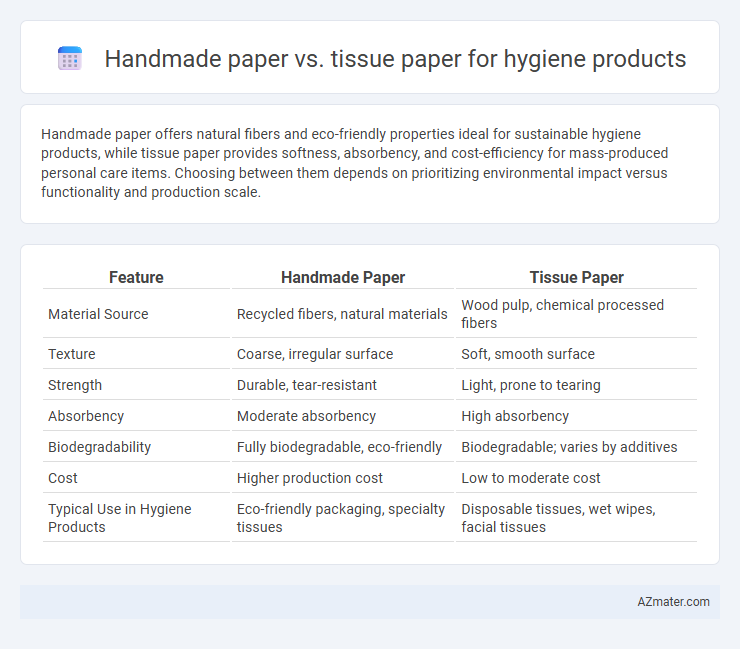Handmade paper offers natural fibers and eco-friendly properties ideal for sustainable hygiene products, while tissue paper provides softness, absorbency, and cost-efficiency for mass-produced personal care items. Choosing between them depends on prioritizing environmental impact versus functionality and production scale.
Table of Comparison
| Feature | Handmade Paper | Tissue Paper |
|---|---|---|
| Material Source | Recycled fibers, natural materials | Wood pulp, chemical processed fibers |
| Texture | Coarse, irregular surface | Soft, smooth surface |
| Strength | Durable, tear-resistant | Light, prone to tearing |
| Absorbency | Moderate absorbency | High absorbency |
| Biodegradability | Fully biodegradable, eco-friendly | Biodegradable; varies by additives |
| Cost | Higher production cost | Low to moderate cost |
| Typical Use in Hygiene Products | Eco-friendly packaging, specialty tissues | Disposable tissues, wet wipes, facial tissues |
Introduction to Handmade Paper and Tissue Paper
Handmade paper, crafted from natural fibers such as cotton, hemp, or recycled materials, offers enhanced durability and eco-friendliness compared to mass-produced tissue paper. Tissue paper, typically manufactured using wood pulp through mechanized processes, is designed for softness and disposable hygiene applications but often lacks the environmental benefits of handmade varieties. Choosing between handmade and tissue paper depends on the balance between sustainability, texture, and intended hygienic use.
Material Composition and Sourcing
Handmade paper for hygiene products is primarily crafted from natural fibers such as cotton, hemp, or recycled textiles, offering enhanced biodegradability and reduced chemical processing. Tissue paper typically consists of wood pulp derived from softwood or hardwood trees, often involving bleaching agents and additives to achieve softness and absorbency. Sourcing handmade paper emphasizes sustainable agricultural byproducts and local raw materials, while tissue paper production depends heavily on commercial forestry and large-scale pulp processing facilities.
Manufacturing Processes Compared
Handmade paper for hygiene products is crafted through a labor-intensive process involving natural fibers soaked, pulped, and formed using molds, resulting in a textured, eco-friendly material ideal for sustainable applications. Tissue paper manufacturing employs high-speed machines that convert wood pulp into thin, soft sheets through pressing, drying, and calendaring, optimizing absorbency and softness for consumer use. The artisanal method of handmade paper contrasts with the mechanized, large-scale production of tissue paper, impacting cost, texture, and environmental footprint significantly.
Softness and Skin Friendliness
Handmade paper offers superior softness and excellent skin friendliness due to its natural fibers and minimal chemical processing, making it ideal for sensitive skin in hygiene products. Tissue paper, often mass-produced with additives and synthetic materials, can sometimes cause irritation or discomfort with prolonged contact. The eco-friendly composition of handmade paper enhances breathability and reduces allergic reactions, providing a gentler experience compared to conventional tissue paper.
Absorbency and Performance
Handmade paper typically offers lower absorbency compared to tissue paper, making it less effective for hygiene products that require quick moisture absorption and retention. Tissue paper is engineered to have superior softness and strength while maintaining high absorbency, ideal for personal care applications such as facial tissues and toilet paper. The fibrous structure and chemical treatment of tissue paper enhance its performance by providing better liquid wicking and durability during use.
Environmental Impact and Sustainability
Handmade paper for hygiene products offers a biodegradable and eco-friendly alternative to conventional tissue paper, reducing plastic pollution and lowering carbon footprints through minimal chemical processing and recycling natural fibers. Tissue paper, while convenient and widely used, often relies on industrial manufacturing processes that consume significant water, energy, and contribute to deforestation unless sourced from certified sustainable forests or recycled content. Choosing handmade paper supports sustainable resource management and waste reduction, making it a preferable option for environmentally conscious hygiene care.
Cost and Accessibility
Handmade paper is often more expensive and less accessible than tissue paper due to its labor-intensive production and limited manufacturing facilities. Tissue paper benefits from mass production techniques, making it widely available and cost-effective for hygiene products. The affordability and easy accessibility of tissue paper ensure its dominance in everyday hygiene applications.
Hygiene and Antibacterial Properties
Handmade paper offers superior antibacterial properties due to its natural fibers and minimal chemical processing, making it a more hygienic option for sensitive skin hygiene products. Tissue paper, often treated with chemicals and fragrances, can harbor bacteria and cause irritation, reducing its suitability for hygiene applications. The porous structure of handmade paper also enhances breathability and moisture absorption, promoting better hygiene maintenance.
Customizability and Aesthetic Appeal
Handmade paper offers superior customizability in hygiene products with unique textures, thickness variations, and organic finishes that enhance aesthetic appeal, making each piece distinct and visually appealing. Tissue paper, while highly functional and soft, generally lacks the artistic charm and bespoke qualities found in handmade alternatives, as it is mass-produced with uniformity prioritized over individuality. Consumers seeking personalized hygiene products with artisanal flair often prefer handmade paper for its natural beauty and tactile richness that elevate everyday use.
Choosing the Right Paper for Hygiene Products
Handmade paper offers a natural, biodegradable option with a unique texture, but it lacks the softness and absorbency required for hygiene products, making tissue paper the preferred choice for personal care. Tissue paper is specifically engineered for hygiene use, providing superior softness, strength, and quick absorption crucial for comfort and cleanliness in products like facial tissues and toilet papers. Selecting tissue paper ensures optimal hygiene performance, whereas handmade paper may be better suited for sustainable packaging or decorative purposes in the hygiene industry.

Infographic: Handmade paper vs Tissue paper for Hygiene product
 azmater.com
azmater.com